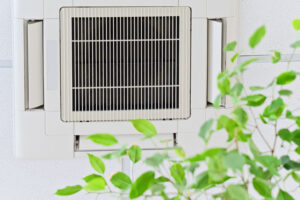Most homeowners worry about visible problems like leaks, cracks, or outdated wiring. However, indoor air quality (IAQ) is an equally critical factor affecting the health and comfort of your home. Poor air quality can lead to allergies, respiratory problems, and even long-term health risks. The good news? A professional home inspection can uncover hidden air quality issues, allowing you to take proactive steps before they become major concerns.

Why Indoor Air Quality Is a Big Deal
The air inside your home can be 2 to 5 times more polluted than outdoor air, according to the EPA. Poor IAQ can cause symptoms like:
- Frequent headaches or dizziness
- Allergies, coughing, and congestion
- Worsening asthma or respiratory conditions
- Fatigue and trouble concentrating
Many of these issues stem from pollutants like mold, radon, asbestos, and carbon monoxide—problems that can go unnoticed without a professional inspection.
How a Home Inspection Can Identify Air Quality Risks
A thorough home inspection from First Choice Inspectors assesses multiple factors that affect indoor air quality. Here’s how we help:
1. Detecting Hidden Mold & Mildew
Mold thrives in damp, poorly ventilated areas such as basements, attics, and crawl spaces. Not only can mold damage your home’s structure, but its spores can also trigger allergies and respiratory issues. A home inspector checks for moisture problems, leaks, and signs of mold growth so you can take action early.
2. Testing for Radon Gas
Radon is a silent and invisible threat that seeps into homes through cracks in the foundation. It’s a leading cause of lung cancer, yet most homeowners don’t test for it. A radon inspection ensures your home is safe, and if levels are high, mitigation solutions can be installed.
3. Checking for Asbestos & Lead Hazards
Older homes may contain asbestos in insulation, ceiling tiles, and flooring, which can become airborne if disturbed. Lead-based paint (common in homes built before 1978) can also pose health risks if it deteriorates. A professional inspection can determine whether these materials are present and if removal or containment is needed.
4. Evaluating Ventilation & Carbon Monoxide Risks
Good ventilation is essential for clean air. A home inspection will assess HVAC systems, exhaust vents, and carbon monoxide detectors to ensure your home isn’t accumulating harmful gases or pollutants.
5. Assessing HVAC System Performance
Your heating, ventilation, and air conditioning (HVAC) system plays a key role in air quality. If it’s clogged with dust, mold, or debris, it can circulate allergens and contaminants throughout your home. An inspection will determine if maintenance or filter replacements are needed to improve airflow.
Ways to Improve Indoor Air Quality After an Inspection
Once your home has been inspected, you can take steps to enhance air quality:
- Repair leaks & improve ventilation to reduce moisture buildup
- Install a radon mitigation system if high levels are found
- Replace HVAC filters regularly for cleaner air circulation
- Use air purifiers & houseplants to help remove toxins
- Choose low-VOC paints & eco-friendly cleaners to limit chemical exposure
Schedule a Home Inspection to Ensure Clean, Safe Air
Indoor air quality is a critical part of a healthy home, and a professional inspection can help identify and address hidden dangers before they become serious issues.
At First Choice Inspectors, we provide comprehensive home inspections in Chicago, including mold, radon, asbestos, and ventilation checks to ensure a safer, healthier living space.
Call us today at 773-429-9711 or visit FirstChoiceInspectors.com to schedule your inspection!